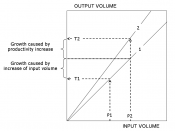Risks of sustained high CAD include:
- Growth of foreign liabilities - A CAD results in financial inflow, either in the form of borrowing from overseas (foreign debt) or through selling equity in items such as property/companies (foreign equity). This will mean that lenders may become more reluctant to lend to Aus or to invest in Aus, and decisions affecting the Aus economy will increasingly be made by international businesses and not be Australians
- Increased servicing costs associated with high levels of foreign liabilities impose substantial servicing costs, reflected by the large net income deficit on the CAD. Foreign debt must be serviced through interest payments that vary according to the level of interest rates in Aus & overseas, and profits must be returned on foreign equity investment can contribute to the problem of the debt trap, in which Aus is borrowing money simply to service its existing foreign liabilities (borrowing to pay off debt, only creating further debt - debt trap)
- Increase volatility for exchange rates - high CAD may undermine the confidence of overseas investors in the Aus economy & by reducing demand for Aus currency, a depreciation of $A may occur.
A depreciation of the $A will generally worsen Aus's CAD problem in the short term, as price of imports & costs of servicing foreign debt increases
- Constraint on future economic growth - in longer term, CAD acts as speed limit on economic growth. Higher levels of economic growth generally involve an increase in imports & deterioration of CAD. Economies with a CAD problem are therefore forced to limit growth to the level at which the CAD is sustainable - balance of payments constraint
- More contractionary economic policy - in order to reduce a high CAD in the short term, govt's...


